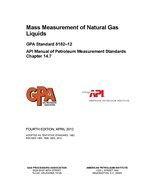No products
 View larger
View larger
API MPMS Chapter 14.7
M00042676
New product
API MPMS Chapter 14.7 Mass Measurement of Natural Gas Liquids, Fourth Edition
Handbook / Manual / Guide by American Petroleum Institute, 04/01/2012
Full Description
This standard serves as a reference for the selection, design, installation, operation and maintenance of single-phase dynamic liquid mass measurement systems that operate in the 351.7 kg/m3 to 687.8 kg/m3 (0.350 to 0.688 relative density at 60 F) density range. The mass measurement systems within the scope of this document include inferred mass measurement, where volume at flowing conditions is combined with density at similar conditions to result in measured mass, as well as Coriolis mass measurement.Liquids with density below 351.7 kg/m3 and above 687.8 kg/m3 (below 0.350 and above 0.688 relative density at 60 F) and cryogenic fluids (colder than approximately 50.8 F) are excluded from the scope of this document, but the principles described herein may apply to such streams.
NGL product should be analyzed to determine the mixture composition and the composition should be considered in determining the measurement methods and equipment to be used. It is especially important to use mass measurement whenever the range of molecular sizes is great, such as in high ethane content (more than 2 % to 5 % ethane) raw make, and when mixture composition is variable during the measurement period. It is less critical when the sizes of molecules in the mixture are similar, such as in the case of mixed butanes.
Sampling equipment and techniques are covered including standards for analytical methods used to determine the composition of the sampled product. Equations of state and correlations used to calculate the density of the product are discussed. The standard used to convert mass to equivalent liquid volumes of components is also discussed.
Equipment exists which uses diverse principles for measuring volume, sampling the product, and determining the composition and density of the product. This standard does not advocate the preferential use of any particular type of equipment. It is not the intention of this standard to restrict future development or improvement of equipment. The contracting parties to any agreement should mutually agree on the equipment to be used.
In stock
More info
Contents
Page
Scope 1
Normative References 1
Terms, Definitions, and Abbreviations 2
Definitions 2
Abbreviations 3
Mass vs Volumetric Measurement—Accuracy and Precision Implications 3
Mass Determination 3
Direct Mass Measurement 4
Inferred Mass Measurement 4
Orifice Meters 4
Density Determination 4
General 4
Measured Density 5
Empirical 5
Application in Time 6
Volumetric Measurement for Inferred Mass Determination 6
General 6
Displacement Meters 6
Turbine Meters 6
Ultrasonic Meters 6
Coriolis Meters 6
Meter Proving 7
Measurement By Orifice 7
Sampling 7
Sample Analysis 7
Conversion of Measured Mass to Volume 7
Bibliography 8
v
Standard for Mass Measurement of Natural Gas Liquids
Scope
This standard serves as a reference for the selection, design, installation, operation and maintenance of single-phase dynamic liquid mass measurement systems that operate in the 351.7 kg/m3 to 687.8 kg/m3 (0.350 to 0.688 relative density at 60 °F) density range. The mass measurement systems within the scope of this document include inferred mass measurement, where volume at flowing conditions is combined with density at similar conditions to result in measured mass, as well as Coriolis mass measurement.
Liquids with density below 351.7 kg/m3 and above 687.8 kg/m3 (below 0.350 and above 0.688 relative density at 60 °F) and cryogenic fluids (colder than approximately –50.8 °F) are excluded from the scope of this document, but the principles described herein may apply to such streams.
NGL product should be analyzed to determine the mixture composition and the composition should be considered in determining the measurement methods and equipment to be used. It is especially important to use mass measurement whenever the range of molecular sizes is great, such as in high ethane content (more than 2 % to 5 % ethane) raw make, and when mixture composition is variable during the measurement period. It is less critical when the sizes of molecules in the mixture are similar, such as in the case of mixed butanes.
Sampling equipment and techniques are covered including standards for analytical methods used to determine the composition of the sampled product. Equations of state and correlations used to calculate the density of the product are discussed. The standard used to convert mass to equivalent liquid volumes of components is also discussed.
Equipment exists which uses diverse principles for measuring volume, sampling the product, and determining the composition and density of the product. This standard does not advocate the preferential use of any particular type of equipment. It is not the intention of this standard to restrict future development or improvement of equipment. The contracting parties to any agreement should mutually agree on the equipment to be used.
Normative References
The following referenced documents are indispensable for the application of this document, or provide additional information pertinent to mass measurement of natural gas liquids. For dated references, only the edition cited applies. For undated references, the latest edition of the referenced document (including any amendments) applies.
API MPMS Chapter 5.2, Measurement of Liquid Hydrocarbons by Displacement Meters
API MPMS Chapter 5.3, Measurement of Liquid Hydrocarbons by Turbine Meters
API MPMS Chapter 5.4, Accessory Equipment for Liquid Meters
API MPMS Chapter 5.6, Measurement of Liquid Hydrocarbons by Coriolis Meters
API MPMS Chapter 5.8, Measurement of Liquid Hydrocarbons by Ultrasonic Flowmeters Using Transit Time Technology
API MPMS Chapter 11.2.2, Physical Properties Data—Compressibility Factors for Hydrocarbons
API MPMS Chapter 11.2.4, Physical Properties Data—Temperature Correction for the Volume of NGL and LPG Tables 23E, 24E, 53E, 54E, 59E & 60E
API MPMS Chapter 12.2, Calculation of Petroleum Quantities
1

